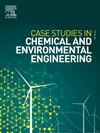鲶鱼和黑头鱼不同鱼骨提取天然纳米钙的理化性质
Q1 Environmental Science
Case Studies in Chemical and Environmental Engineering
Pub Date : 2024-12-26
DOI:10.1016/j.cscee.2024.101080
引用次数: 0
摘要
在人口迅速老龄化的背景下,骨质疏松症已成为印度尼西亚一个重大的公共卫生问题。骨质疏松症是一种由于骨骼结构恶化而导致骨骼脆弱的疾病。预防策略侧重于增加富含钙的食物摄入。通常作为废物丢弃的鱼骨,由于其高含量,与传统补充剂类似,提供了一种有价值的钙替代品。然而,鱼骨粉的钙吸收是有限的,导致潜在的缺陷。纳米技术通过将钙颗粒降低到纳米级来解决这个问题,显著提高了生物利用度。这项研究探索了从各种鱼骨中提取的天然纳米钙的潜力。鱼骨粉(FBP)的粒径分布在纳米范围内(393.30 nm和744.93 nm)。傅里叶变换红外光谱证实了酰胺峰的存在,如酰胺I (1649-1662 cm−1),酰胺II (1548-1552 cm−1),酰胺III (1242-1244 cm−1)和磷酸盐(565-569和605 cm−1)。场发射扫描电镜鉴定FBP为方解石。能量色散x射线分析表明,蛇头FBP的CaO含量最高,而x射线衍射光谱图表明,鲶鱼FBP的结晶度最高。营养分析表明,鲶鱼FBP中灰分、脂肪、钙和磷含量较高,而黑鱼FBP中蛋白质含量较高(53.25±0.94%)。这些结果表明,纳米技术提高了鱼骨中的钙含量,将通常被认为是废物的东西转化为纳米钙的宝贵天然来源,以解决缺钙问题并改善骨骼健康。本文章由计算机程序翻译,如有差异,请以英文原文为准。
Physico-chemical characterization of natural nano calcium extracted from different fish bones in catfish (Clarias gariepinus) and snakehead fish (Channa striata)
Amidst a rapidly aging population, osteoporosis, a condition that causes weakened, fragile bones due to deteriorating bone structure, has become a significant public health concern in Indonesia. Prevention strategies focus on increasing calcium-rich food intake. Fish bones, typically discarded as waste, offer a valuable alternative for calcium due to their high content, similar to traditional supplements. However, calcium absorption from fish bone flour is limited, leading to potential deficiencies. Nanotechnology addresses this by reducing calcium particles to nanoscale, significantly improving bioavailability. This research explores the potential of naturally occurring nano-calcium derived from various fish bones. The particle size analysis of fish bone powder (FBP) revealed that all samples were in the nanometer range (393.30 and 744.93 nm). The Fourier Transform Infrared spectra confirmed the presence of amide peaks, such as amide I (1649-1662 cm−1), amide II (1548-1552 cm−1), amide III (1242-1244 cm−1), and phosphate (565–569 and 605 cm−1). The field emission scanning electron microscopy identified FBP as calcite. The Energy-dispersive X-ray analysis showed that snakehead FBP had the highest CaO content, while the X-Ray Diffraction spectra pattern determined that catfish FBP exhibited the highest crystallinity. The nutritional analysis indicated that catfish FBP contained more ash, lipids, calcium, and phosphorus, while snakehead FBP was richer in protein (53.25 ± 0.94 %). These results suggest that nanotechnology enhances the calcium content in fish bones, transforming what is typically considered waste into a valuable natural source of nano-calcium to address deficiencies and improve bone health.
求助全文
通过发布文献求助,成功后即可免费获取论文全文。
去求助
来源期刊

Case Studies in Chemical and Environmental Engineering
Engineering-Engineering (miscellaneous)
CiteScore
9.20
自引率
0.00%
发文量
103
审稿时长
40 days
 求助内容:
求助内容: 应助结果提醒方式:
应助结果提醒方式:


